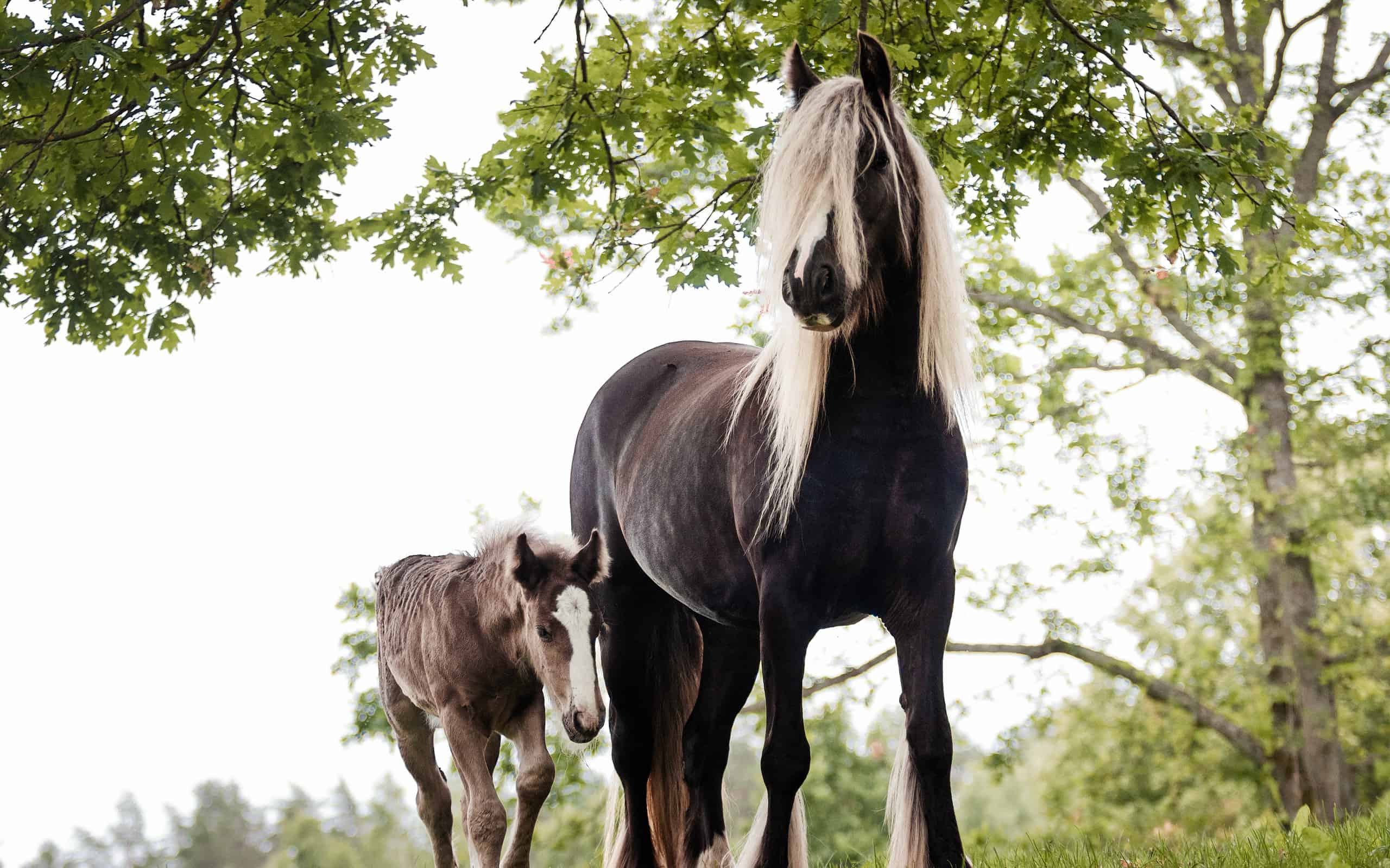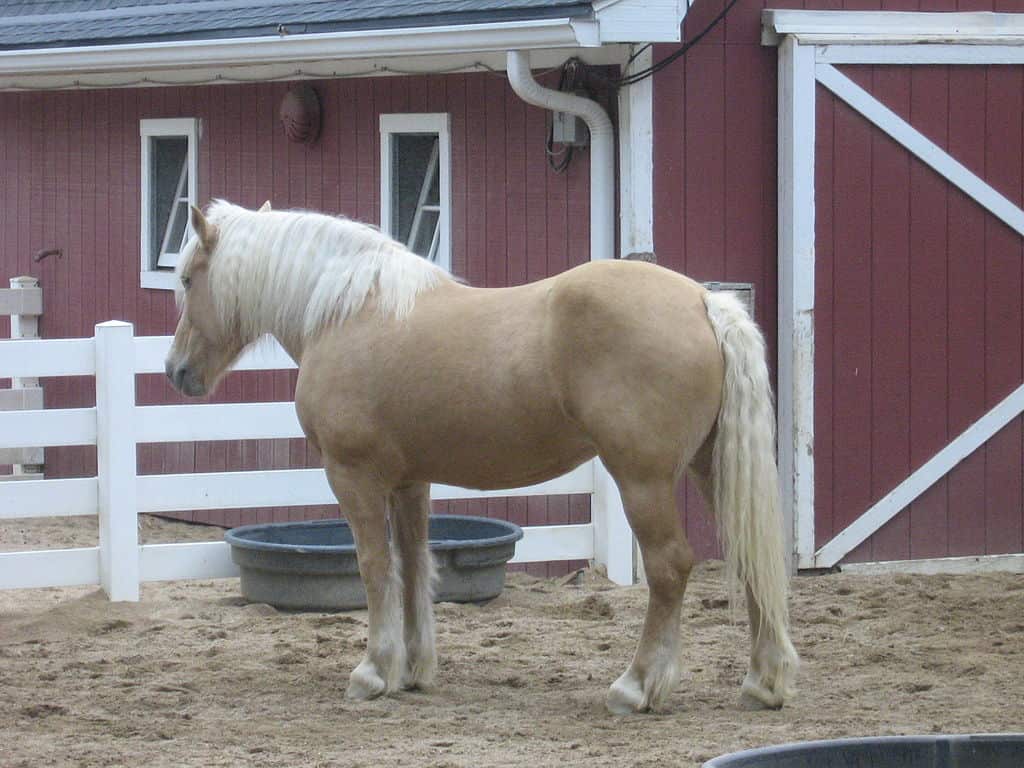Ever wondered just how many horse colors there are? Well, we’ve done the work to bring in every color, variation, pattern, and marking we could think of just for you! You’ll find the rarest and most common horse colors alike, with information on base coat colors, markings, and more. Let’s take a look and see how many you already knew.
The 4 Base Horse Colors
All horses have one of four base colors. Depending on genetics, mutations, parental lineage and coloration, these base colors may skew to some of the more unusual shades or remain mostly or entirely present as the horse’s color.
- Bay
- Black
- Brown
- Chestnut
Rarest Horse Colors
Mushroom
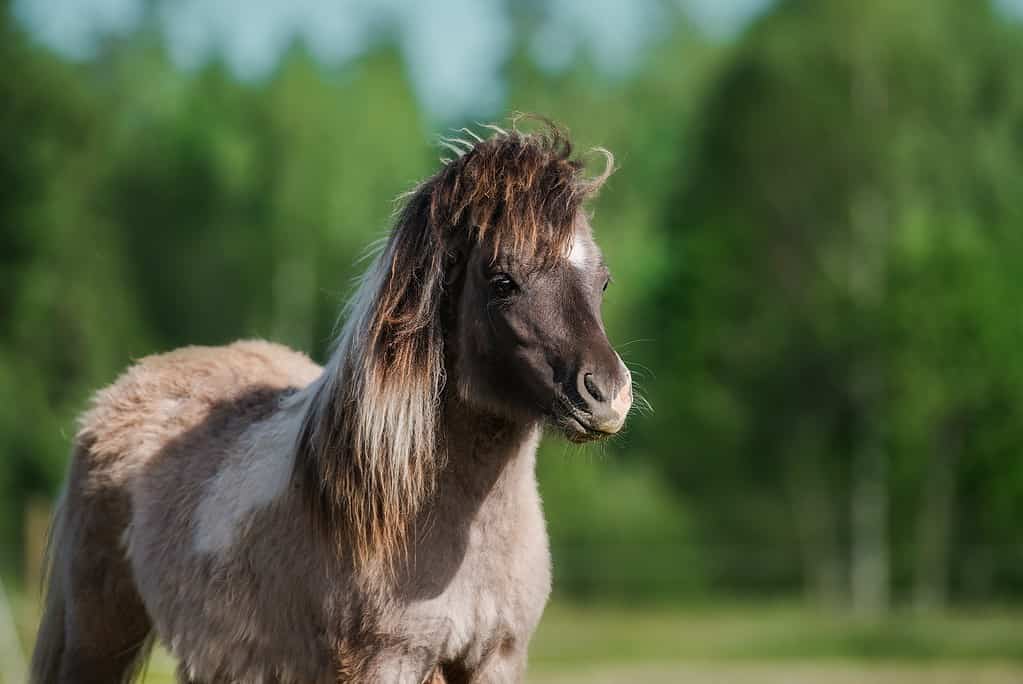
Mushroom
horse
color
©Rita_Kochmarjova/Shutterstock.com
Perhaps the rarest horse color of all, the mushroom comes in a base color of chestnut or bay, with any skin color and dark eyes. The dilution gene has only been identified since 2014 but it results in a lightening of red tones in the horse’s base coat, giving the horse an almost sepia appearance. The horses are born in pale beige and as they mature, the coloration may remain or may dissipate. When adult, they may have a gray or pinkish tint, as well. In order to produce a mushroom coloring, both parents must carry this dilution gene. The gene may appear in black horses, as well, but it won’t affect their coloring.
Chimera
Rather than being a specific color, the chimera “coloring” comes from a rare DNA error that earns the bizarre name for the condition. Chimerism, extremely rare in horses, results from two non-identical twins fusing within the womb. A horse born of this winds up with two sets of DNA. Both sets show in the coat colors of the horse at birth. The combination displayed could be any two horse colors, with patterns based on what the two horses would have produced individually had the fusion not occurred. This condition is not passed from one horse to its offspring.
Brindle

Brindle horse coloring
©Yuniia Andriichuk/Shutterstock.com
Brindle coloring comes as a form of chimerism. This particular coloring may be common in dogs and other animals, but in horses, the brindle stripes are exceptionally rare. The pattern may appear on any base coat color, resulting from the same fusion of two embryos as in any other chimera horse. The stripes may be the same or differently textured to the rest of the horse coat, but they are always vertical and do not extend to the legs or head. Like other chimerism, the pattern is not considered inheritable, however, in 2016, one identifiable gene Brindle1 or BR1 was identified within a specific American Quarter Horse family.
True White

True white horse
©iStock.com/Margarita Solianova
True white horses are quite rare, with full white coats and pink skin beneath. These horses may have brown or blow eyes, depending on the exact genetics that make the horse this color.
Cremello
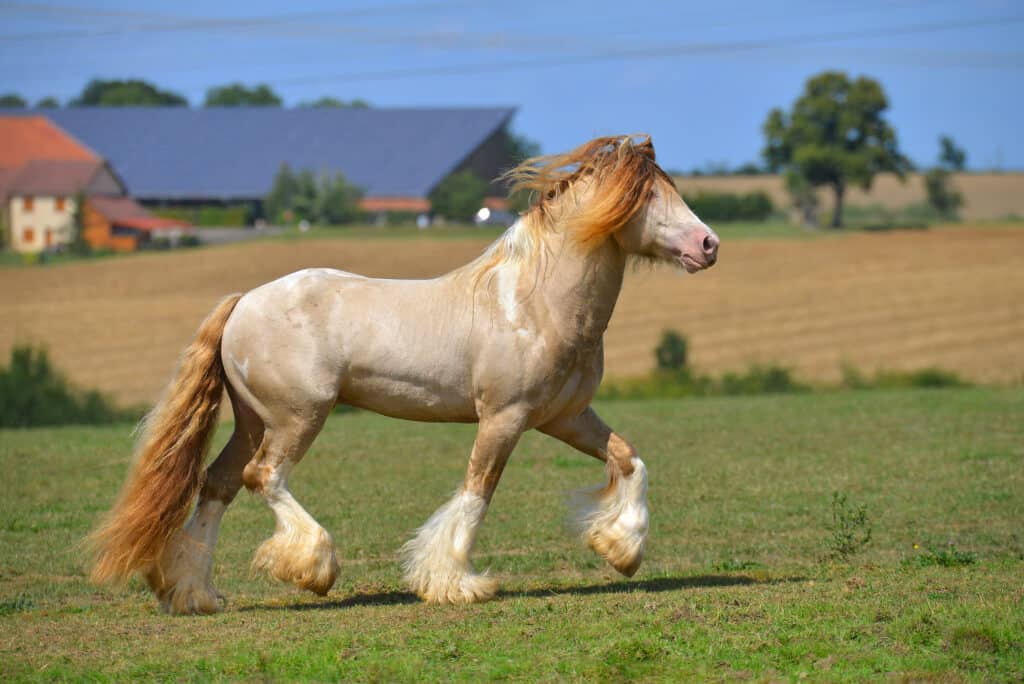
Cremello horse
©arthorse/Shutterstock.com
A homozygous cream chestnut, the cremello horse comes in the rare cream coloring over pink skin, with blue eyes. Some folks mistake cremello horses for albinos or white horses, but the genetics are different. The cremello has a chestnut base color with two dilution genes that lighten the hair to nearly white. Often, these rare horses appear in Lusitano, Akhal-Teke, and specific pony breeds.
Perlino
A very pale coat, typically in champagne or cream, rests over perlino colored horses. They typically have blue or amber eyes. Underneath the pale coats, pink skin shines through, adding a sort of pink-ish shade to the coat. Some folks call perlinos pseudo-albino horses. The pale cream coloring may vary from pale off white to pale coffee brown with that pink under coat, particularly in summer.
Sorraia
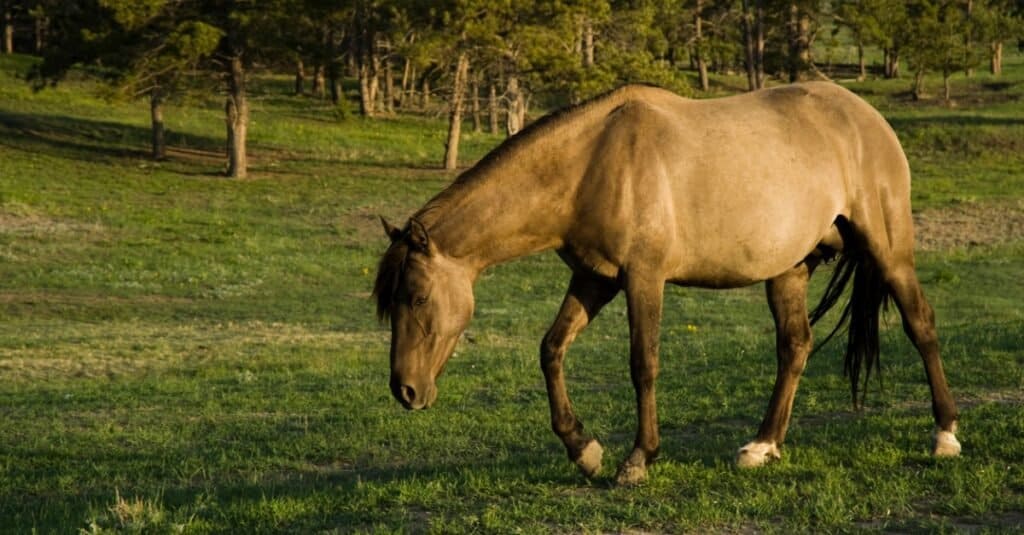
Sorraia horse
©iStock.com/karenparker2000
Normally, a dun-colored or grullo horse creates the sorraia coloring variation. If in dun, the sorraia coloring also means a black dorsal stripe. Sometimes, the horses bear horizontal stripes on their legs nd heads, with black tipped ears.
Camarillo White
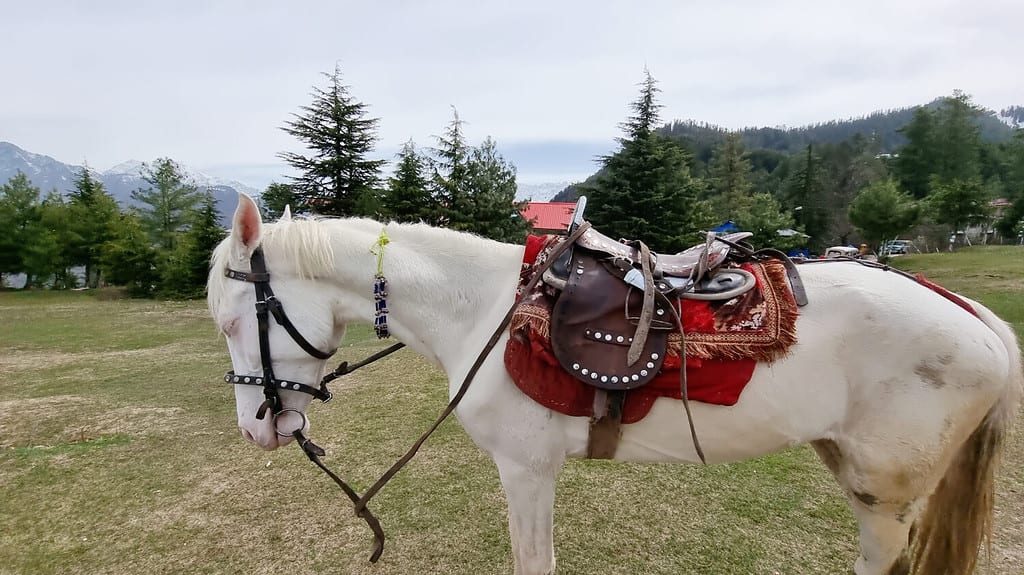
Camarillo White horse
©Jrs Jahangeer/Shutterstock.com
The Camarillo white horse is a true, all white horse with pink skin beneath the coat. The horses are born in light colors that don’t darken as they age. The bright white appearance sticks with the rare Camarillo horse their entire lives, including through the mane and tail.
Silver Buckskin
A true silver buckskin horse carries the silver gene, which only affects black hair pigment. The result of this gene is the rare color form of dark points and silver overall coat on the horse. The rare gene lightens the otherwise dark hairs over the horse’s body, producing this silvery sheen. The mane and tail will also come out silver, though the black points on ears will remain.
Metallic Sheen
Not technically a color but rather a trait, the metallic sheen gives a certain look to some horses. The horses with this trait look like a shimmery, molten metal has been poured over them. Most commonly, this highly rare trait will be spotted in Akhal-Teke or related horse breeds like Don, Karabakh, and Budyonny, as well as a few Russian breeds that trace back to the Akhal-Teke. The shiny coat of the Akhal-Teke has earned them the nickname of “golden horses” and it’s no wonder why when you see one! The unique metallic look comes from the hair structure of the horse bearing it, rather than specific coloring. The hairs fold on top of each other in a scaled pattern, with each cuticle smooth and flat, creating that metallic sheen. The coloration is most noticeable in champagne, cremello, palomino, and buckskin horses.
Silver Dapple Pinto
The unique coloration of the silver dapple pinto combines the silver dapple coat with the unique pinto pattern. Silver dapples are rare, usually only occurring in the Gypsy Vanner breed and the American Miniature Horse. The horses have a black base color with a silver gene lightening the color, providing the white and gray spots of the pattern.
Buckskin Pinto
Another rare pinto coloring is the buckskin pinto. This horse coloring has bay coloring of buckskins as the base, with cream or gold as the overlaying sheen. Black points on the mane, tail, and legs shine through as well with these unique buckskin pinto patterns. The rare colaration may show up in American Paint Horses, Mustangs, and Gypsy Vanners most commonly.
Sabino

Sabino horse
©Madelein Wolfaardt/Shutterstock.com
Sabino coloring in a horse is more of a pattern than specific coloring. Most sabino horses have partial or fully white legs with belly spots of various sizes in white. The spotting also appears on their faces and other body parts. Some sabinos are completely white.
This coloration may appear on any base color, with one of the more unique combinations being a chocolate sabino on a brown and white coat with red mane.
Chocolate Flaxen

Chocolate flaxen horse
©Au_Cr/Shutterstock.com
Chestnut base coats may produce the chocolate flaxen horse in Rocky Mountain or Morgan horses, with Black Forest horses exclusively coming in this coloring. A dark chocolate coat overlays the chestnut, with a flaxen tail and mane. This coloring comes from a flaxen modifier gene.
Champagne: Classic, Gold, or Amber
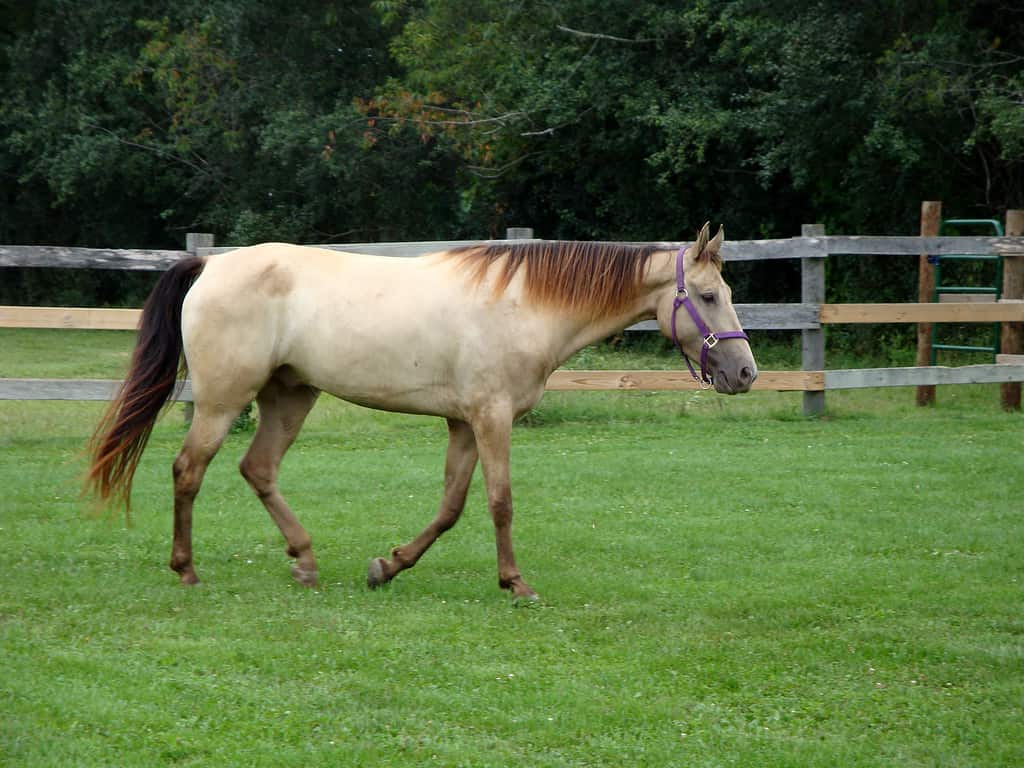
Gold champagne horse
©JP Stock Images/Shutterstock.com
A rare shade in horses, champagne may exist with any base coat color. The coloration results in pink or light lavender skin and horses are born with blue-green eyes that later turn amber, light brown, or hazel. The coloration comes in three shades: gold, amber, or classic champagne, due to the champagne gene.
When horses with chestnut base and champagne gene occurs, they develop a gold champagne overlay color. Black base horses with the champagne gene develop the classic champagne coloring. Bay horses with the gene create amber champagne coloring.
At least one parent with the champagne gene is required to create the champagne horse. The result is a horse born with bright pink skin with some freckles developing over time, around the muzzle, sheath, eyes, and under the tail. Sometimes, champagne horses develop a metallic sheen to them. They have a 50 to 100 percent chance of passing the gene on to their offspring.
Smoky Cream
Another rare color is the smoky cream. These horses have black as their base coat, with dark pink skin coloring and blue or glass eyes. The smoky color comes from a double cream dilution gene. The result is a pale, coffee-to-cream hue with manes and tails in smoky blue, yellow, sooty, or coffee-brown. Lower legs tend to be darker than the body, as well. These smoky creams are often confused with cremellos and perlinaos, but the base black usually shines through on the creams to help distinguish them.
Smoky creams may come in American Quarter, Saddlebred, Tennessee Walking, Missouri Fox Trotter, Andalusian, or American Paint horse breeds most commonly.
Chocolate Palomino
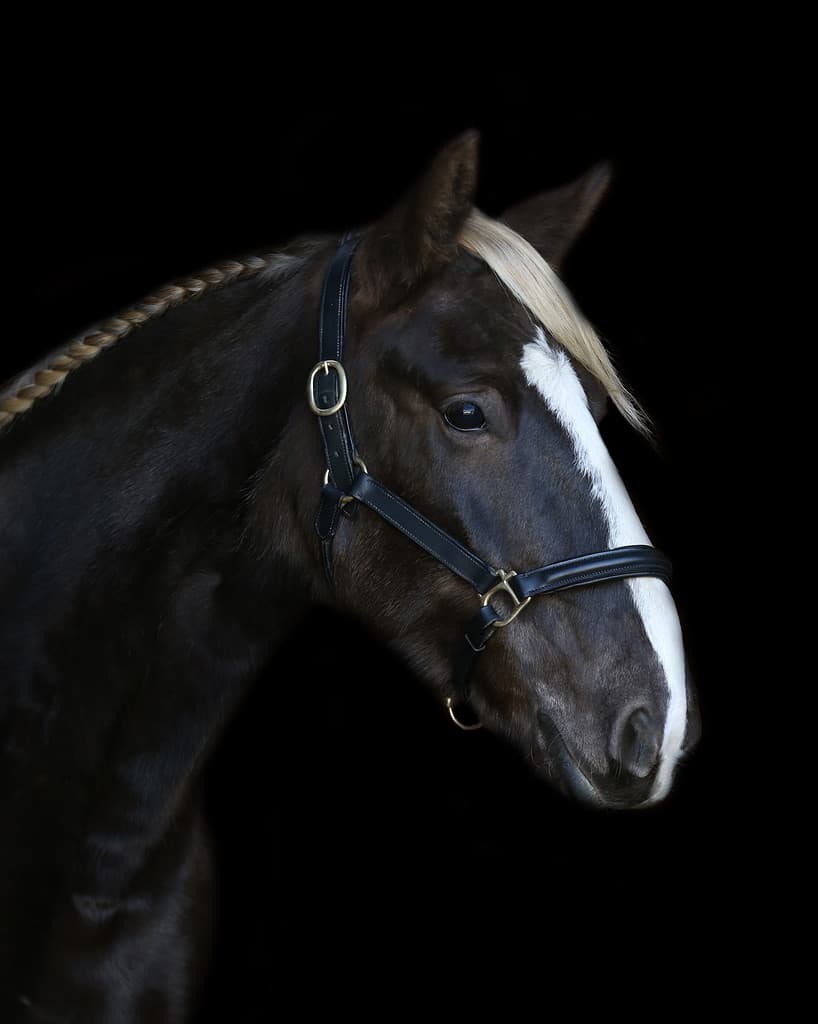
Chocolate palomino mare
©Allyssia Timberlake/ via Getty Images
The unique chocolate palomino horse usually results from pairing a liver chestnut horse with a palomino colored horse. The extremely rare result has dark skin coloring, brown eyes, and a chestnut base coat. The chocolate palomino has an overall deep, dark golden color as deep as dark chocolate in shade, with a few strands of black or brown in their manes and tails.
Pearl
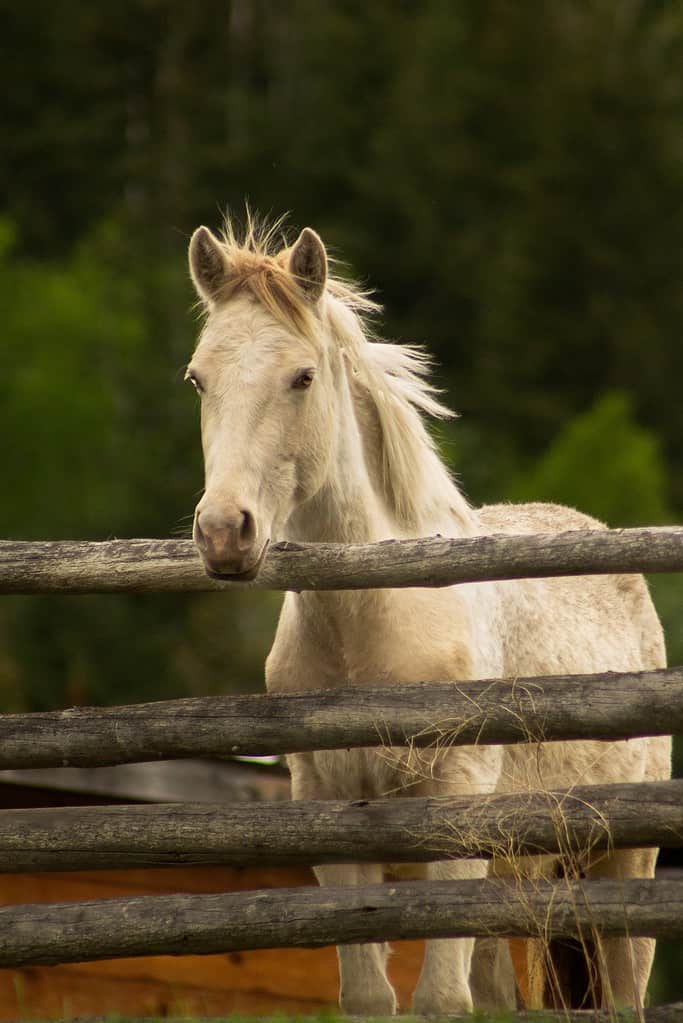
Pearl horse
©Prism Acres Rebecca Young/Shutterstock.com
An extremely rare coloration, pearl mainly shows up in horses with Spanish origins. The color occurs due to a dilution gene known as the “barlink factor” which lightens the horse’s base color. Typically, this coloration gives horses blue eyes and appears as a pearl chestnut. Sometimes, it may appear in other colors as well, from black to palomino. These beauties are often confused with cremellos or perlinos, though, if they have a cream gene, in particular. Pearl color horses tend to have a slightly dark, more yellow coat than the others. Pearl Andalusians and Pearl Lusitanos are particularly favored with this coloring but are extremely expensive because of their rarity.
Sooty Buckskin
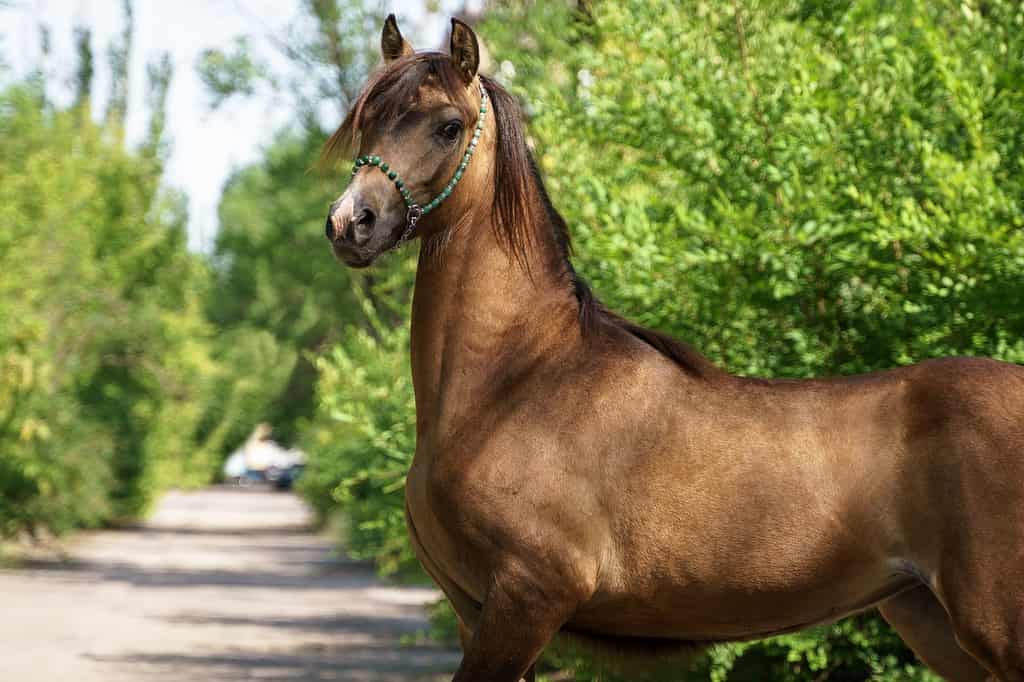
Sooty Buckskin horse
©Ashur_Ro/Shutterstock.com
A unique variety of buckskin coloration is the sooty buckskin. This occurs when black hairs spread across the horse’s shoulders, thighs, and top line, resulting in a sooty looking “coat” over the standard color of the horse. Most horse breeds can occur in this coloration, but it is uncommon.
Rabicano
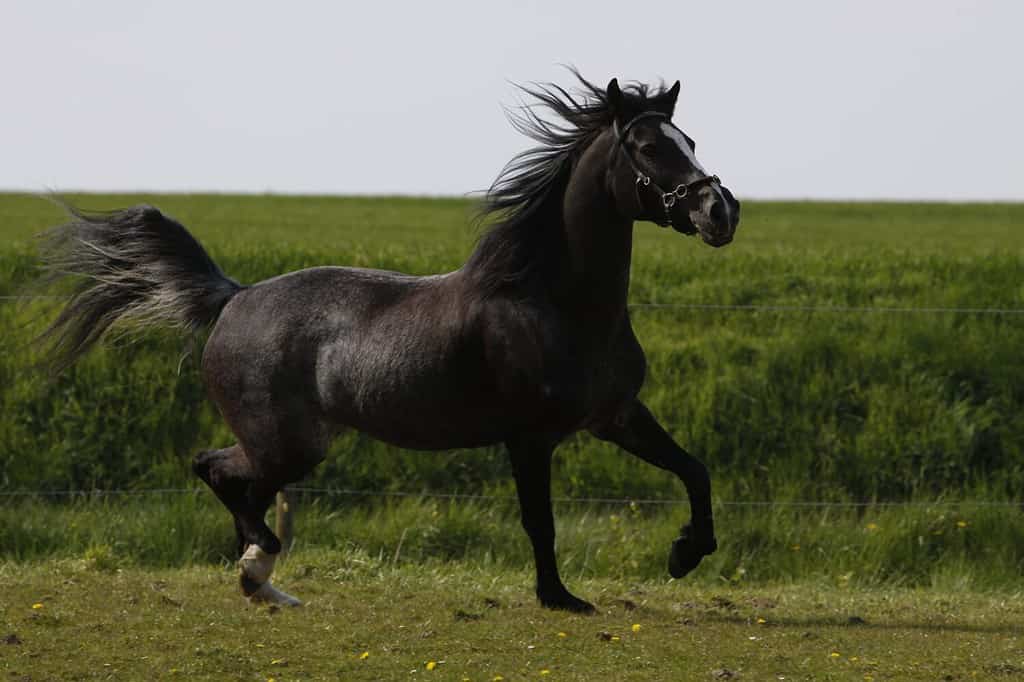
Rabicano color horse
©Sabine Hagedorn/Shutterstock.com
Rabicano is also more of a pattern in white than a specific coloring. However, this white pattern comes with darker shade horses so rarely that the gene which causes it has become a focus in genetic studies. The white pattern is thought to come from a single dominant allele. The white hair appears on various parts of the horse’s coat, including at the tail base and barrel. The pattern isn’t a solid one like that of a sabino or pinto, but rather a “spotting” of white hairs in the dark coat that gives a unique white dry-brushed look to the animal.
Red Rabicano
A Red Rabicano comes with a chestnut base color and sparse roaning coloration on the underbelly, tail, legs, flanks, and head. Basically, this coloration leaves the horse’s back in its base color and touches the other areas with red. Most often, this coloration occurs in black, bay, and chestnut horses.
Most Common Horse Colors and Coat Patterns
Bay
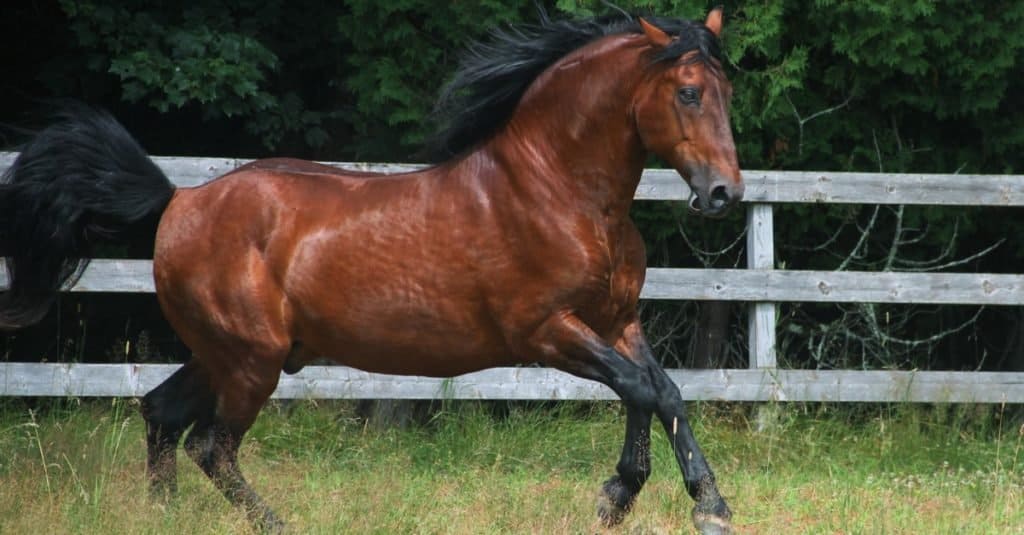
Bay horse
©Liia Becker/Shutterstock.com
The most common color in the majority of horse breeds, the bay is a brown to auburn body with black points at lower legs, muzzles, ear rims, manes, and tails.
Dark Bay
Dark bay horses have the classic black tail, mane, and ears, but their base coat is much darker than the auburn-brown coloring of the standard bay. In some cases, dark bay horses are so dark that folks mistake them for black horses. However, the lighter points at the muzzle, foreleg, and flanks can help identify them as dark bays.
Chestnut

Chestnut horse
©Jaco Wiid/Shutterstock.com
The chestnut horse has a flaxen tail and mane, with reddish brown coats. Chestnuts may come in sorrel to dark or light red-brown shades. Chestnuts don’t have the dark or black points like a bay, however, so may be distinguished this way.
Liver Chestnut
Some chestnuts come in darker shades, almost black or deep chocolatey brown. These have reddish manes and tails and are known as liver chestnuts.
Brown

Brown horse
©Blanscape/Shutterstock.com
Brown horses differ from chestnuts and bays with a dark brown color or dark seal color. The horse will have black points on the legs, mane, and tail, with a reddish-tan or light brown coloring around the muzzle, eyes, front of the stifle, and at the elbows.
Dun
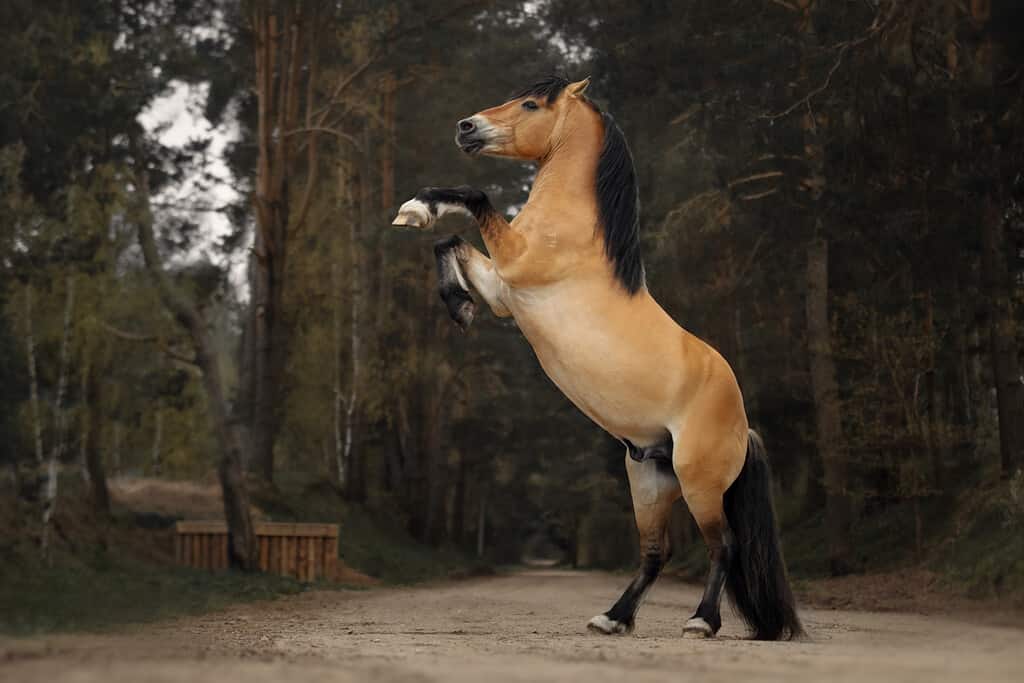
Dun harness horse
©Julia Siomuha/Shutterstock.com
Coming in creamy golden hues, dun horses have black tails and manes, with a distinctive black dorsal stripe. The horse may come in a number of golden to yellow shades, but they always have that dorsal stripe and black points. They may also have shoulder stripes, mane frostings, or cob webbing on their coats. In many cases, the stripes are thought of as zebra-esque coloring.
Buckskin

Metallic bucksin horse
©iStock.com/olgaIT
The unusual buckskin horse may come in a dark, creamy golden color to lighter shades of cream with dark or black points on the manes, tails, ears, and legs. The horse has similar zebra coloring to the dun coloring without the dorsal stripe.
Palomino
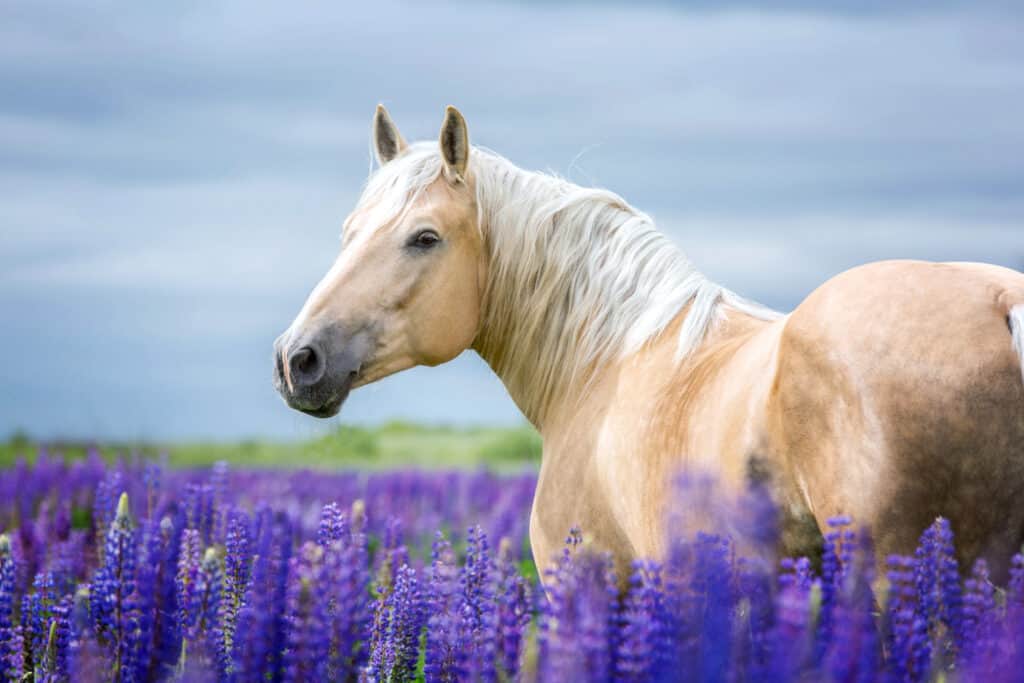
Palomino horse
©Osetrik/Shutterstock.com
Palomino horses may either be the breed known as palomino or a coloring. In the case of coloring, the term refers to creamy or golden-coat horses with white to cream manes and tails. The base color for these horses ranges from a dark golden yellow to a pale yellow-white.
Gray

Gray horse
©Callipso88/Shutterstock.com
Gray is a fairly common horse coloring, though folks often mistake the lighter shades for the rare white horse. The gray horse is usually born with dun, palomino, bay, or chestnut coloring, but turns gray over time. The gray coloring in horses may range from a pale, almost white shade to deep gray.
Flea-bitten Gray
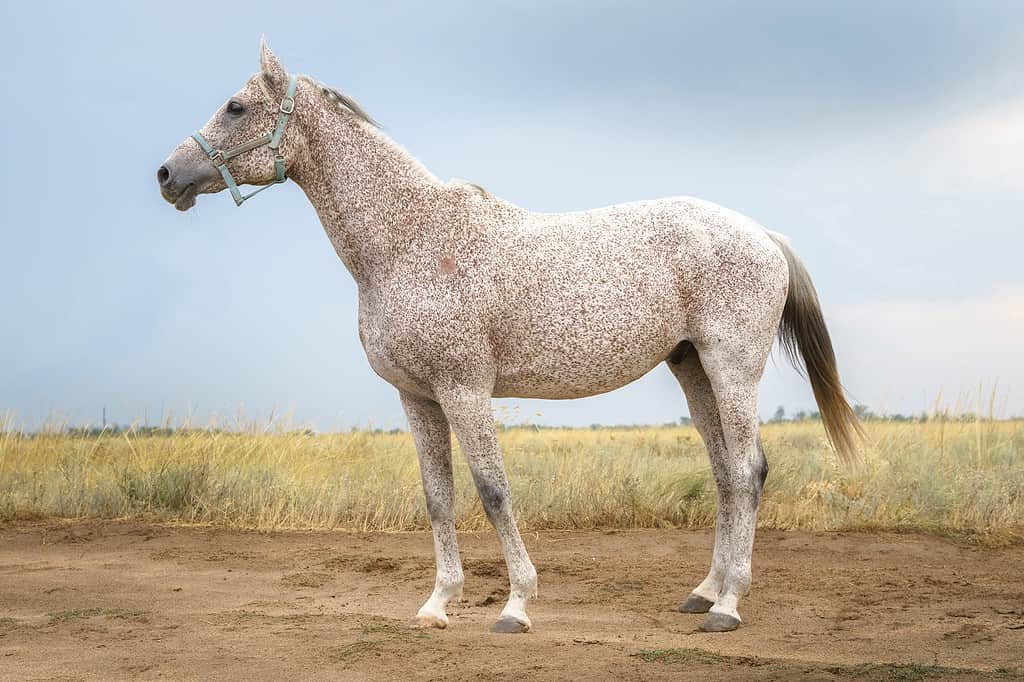
Flea-bitten gray horse
©Ashur_Ro/Shutterstock.com
Sometimes, the gray horse has a white coat with dark gray dots or freckles spotting on the coat. This is known as a flea-bitten gray horse.
Roan
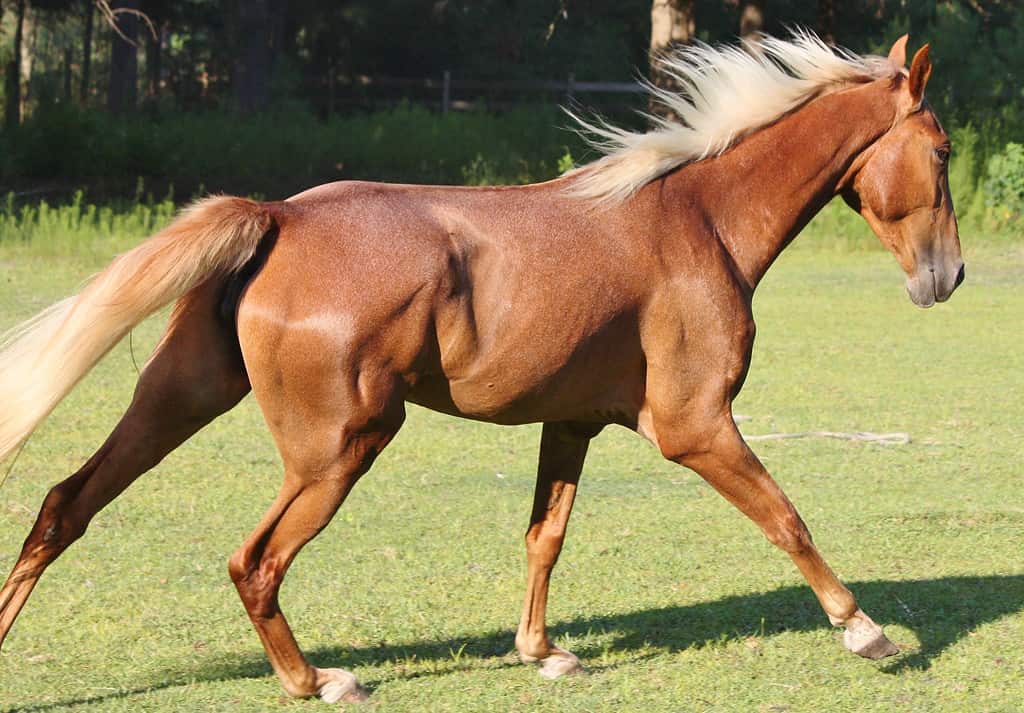
Red roan horse
©aleigha blakley/Shutterstock.com
A roan pattern, or “varnish” shows up as white hairs appearing through the base coat color of the horse. Roan horses are born with this coloring. The variation usually occurs in bays, in several patterns.
- Blue roan — A dark coat with white hairs that makes the horse appear almost blue in color. This comes from a black base and usually has black points.
- Red roan — A chestnut base color with white hairs showing through produces a red to brown coloration.
- Strawberry roan — Strawberry roan comes from a reddish base color with white hairs showing through.
Appaloosa

Appaloosa horse
©Rita_Kochmarjova/Shutterstock.com
The term “Appaloosa horse” applies to both color patterns and a specific breed of American horse. The colorful, spotted coat is the foundation for the coloring, with the breed largely displaying this pattern. Multiple breeds created the horse, genetically speaking, resulting in the unusual patterning. Several varieties of appaloosa patterns exist.
- Appaloosa Roan — A speckled white “blanket” covers the darker base color in a roan pattern. The pattern changes throughout the horse’s lifetime.
- Blanket Appaloosa — White spots over the hips pair with a contrasting base color, like white over black, with distinctive white markings on the horse’s rump.
- Snowcap Appaloosa — Nearly identical to blanket coloring, snowcap coloring has white over the hips or haunches in pure white, with no spotting.
- Leopard Appaloosa — A white coat with black or brown dots speckling throughout creating a leopard-like pattern.
- Frost Appaloosa — Coloring falls between roan and appaloosa, with a solid colored neck and check and roan-like patterns on the belly and haunches.
Pinto
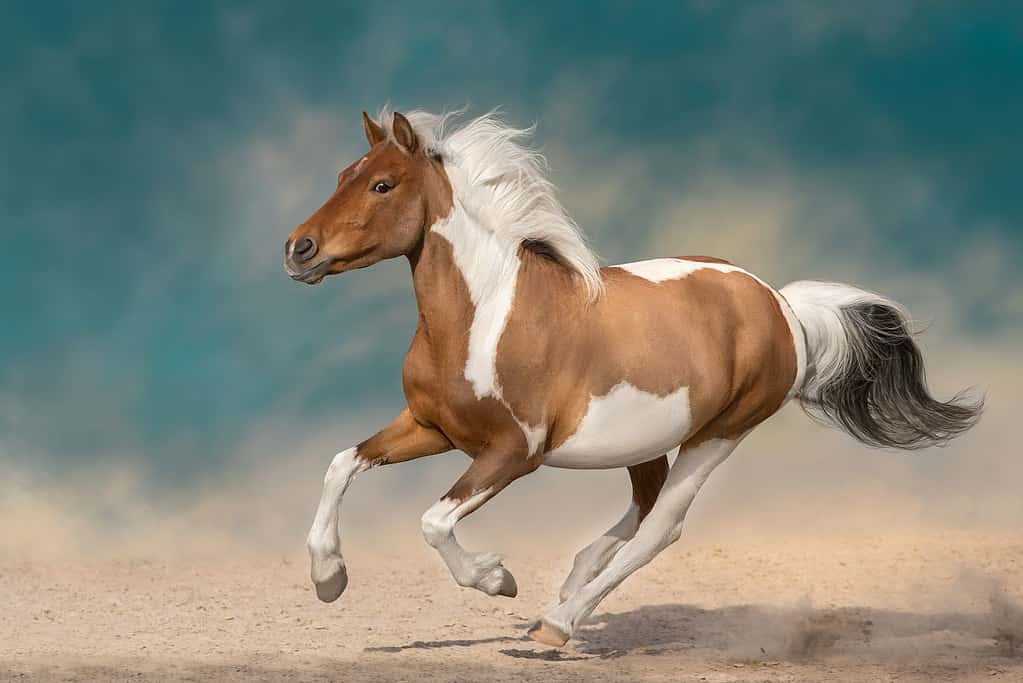
Pinto horse
©Kwadrat/Shutterstock.com
Pinto horses have dark base coat colors, such as black or bay, with white patterns looking a bit like splattered paint on them. The patches or white are usually large. Overall, the pinto horse may bear any variety of combination and colors.
Pinto versus Paint
A paint horse may only belong to the Quarter Horse or Thoroughbred horse breeds. Pintos, on the other hand, are horses with the white pattern on a dark coat of any horse breed.
Sorrel

Sorrel chestnut horse
©Rita_Kochmarjova/Shutterstock.com
A sorrel horse belongs to the chestnut horse color family. The reddish hue of a sorrel stands out from other chestnuts with a browner sheen. Sorrel horses have light reddish coats with blond tails and manes, earning them the nickname of “light” chestnuts.
Overo

Overo horse
©Rita_Kochmarjova/Shutterstock.com
When a darker base coat color horse develops a white pattern stemming from their bellies, these are known as overo-colored horses. The pattern may combine with any base color to create the unique coloration.
Cream
Bays, chestnuts, and black horses may create a cream coloring thanks to a cream dilution gene. This gene makes the base color lighter, producing the cream shade. Often, palominos or buckskin horses with the cream dilution gene appear even lighter than others with the gene.
Dapple Gray
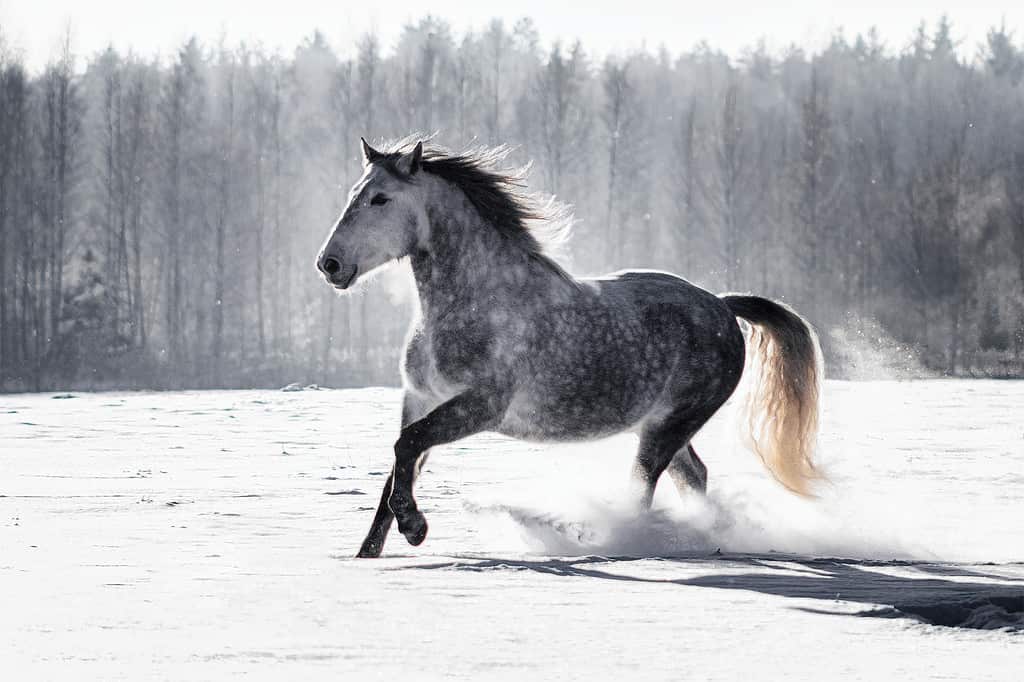
Dappled grey Andalusian (PRE) horse
©Au_Cr/Shutterstock.com
A gray base coloring, created by black with white coloring, creates the dapple gray horse. Splatters or white spots appear throughout their gray coloring, with black points on some horses. Sometimes, the dapple gray with black points may be confused with a blue roan.
Grullo
To create the grullo coloring, a horse must have a dun overlay on a mousy black base color. They have dorsal stripes and stripes on their legs. Sometimes, they have a darker face.
Tobiano

Tobiano horse
©ldc_foto/Shutterstock.com
Spotted color patterns with pink skin patches and white hair mingled into the base color coat creates the tobiano coloring in horses. This is most frequently seen in Pinto horses. You’ll notice white legs and solid-colored heads in this pattern. Base coat colors could be any of the four main base shades.
Skewbald

Skewbald pony
©Plotitsyna NiNa/Shutterstock.com
The skewbald horse may be any color horse with an overo or tobiano pattern, or combination of the two, over a base color in patches, without black coloring.
Piebald
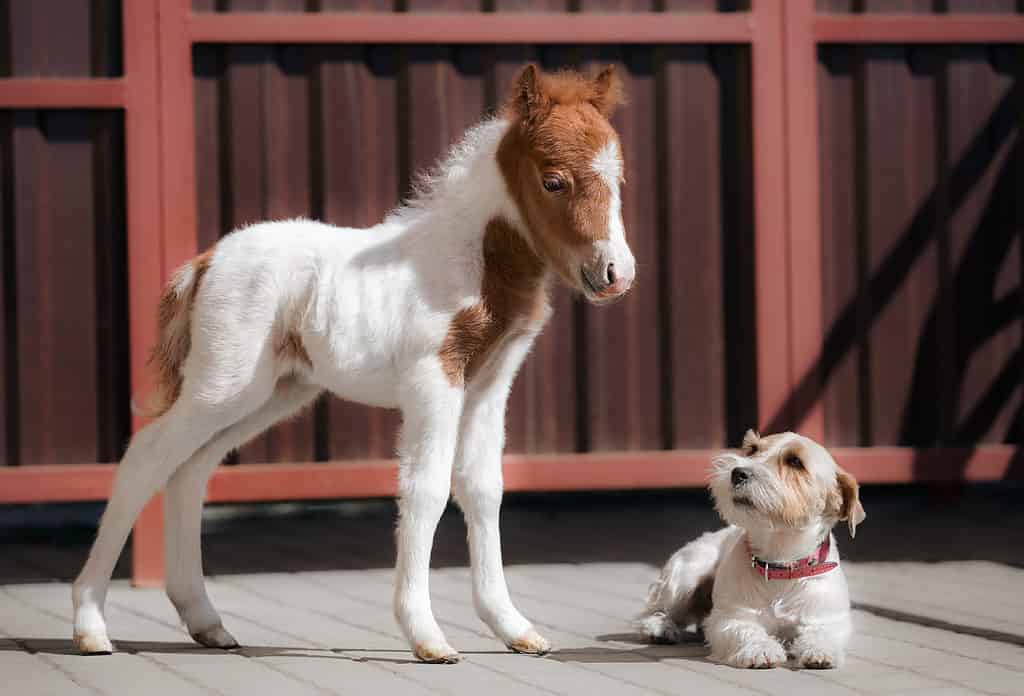
Piebald miniature horse
©OlesyaNickolaeva/Shutterstock.com
Piebald coloring in horses features tovero, overo, or tabiano patterns with a black base coats.
True Black

True black horse
©Kira Felicitas/Shutterstock.com
True black horses have a solid black coat with black points. Sometimes true black horses have white markings like stars or socks. They have brown eyes, black skin, and no brown or reddish hair. On some occasions, they have a blue sheen to their black coats. They’re not particularly rare horses, but some breeds are far less likely to contain true black horses than others.
Splash Overo
The splash overo horse bears a white head, blue eyes, and white markings on the legs and belly. Their backs usually bear their base color in solid.
Horse Face and Body Markings
Just like many cats, dogs, and other animals, horses also have markings on their faces and legs. Most of these markings are in white but may also appear pink in some cases.
Star
Horses with stars have white patches on their foreheads, either large or small.
Snip
Horses may have a small patch of white or pink on their noses or lips. These are called snips.
Stripe
A stripe is a thin white mark running down the horse’s face.
Bald Face
Horses with all white faces lack pigments in their faces. Most commonly, bald faces occur in paint and pintos, often with one or both eyes in blue.
Sock
Similar to ankles socks on people, the sock marking on horses’ legs goes up to the ankle of a horse.
Stocking
Stocking markings on horses are similar to socks, except they extend longer, up to the horse hock or knee.
Thank you for reading! Have some feedback for us? Contact the AZ Animals editorial team.

